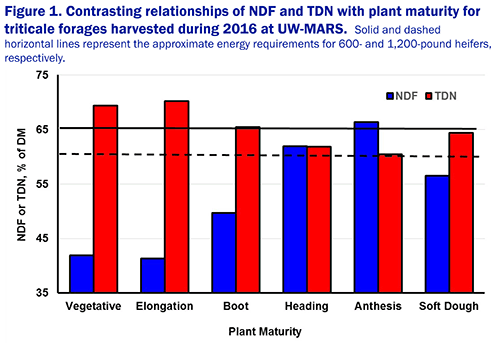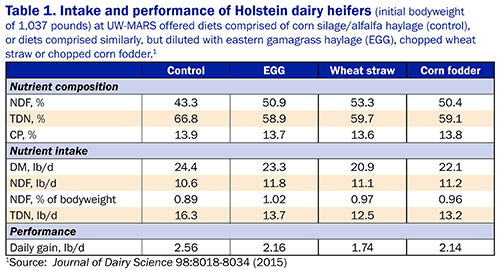
The Importance of NDF in Constructing Dairy Heifer Diets – Dr. Wayne Coblentz, USDA-ARS, and Dr. Matt Akins, University of Wisconsin-Madison
The goal of management programs for dairy replacement heifers is to consistently rear heifers at a low economic and environmental cost without compromising their future performance as lactating cows.
Generally, this can be accomplished with forage-based diets, but a key to success is understanding the role of neutral detergent fiber (NDF) in regulating both the energy density as well as the voluntary intake of diets consumed by dairy heifers. More than a decade ago, Pat Hoffman (then at the University of Wisconsin) established that dairy heifers offered forage-based diets will routinely consume approximately 1 percent of their bodyweight daily in NDF. In reality, this marker is a powerful tool for regulating the growth performance of dairy heifers.
Relationships between forage maturity and NDF and energy
Although most forage producers are aware of these concepts, a brief example of the relationships between forage maturity and nutritive value for triticale forages harvested during 2016 at UW Marshfield Agricultural Research Station (UW-MARS) is shown in Figure 1. As plants mature, the NDF concentration increases, while the energy density of the forage (TDN) declines. However, more in-depth integration of these concepts with the nutritional needs of the heifer is critical.

For instance, the energy density of triticale at the boot stage of growth comes very close to meeting the energy (and protein) requirements for a 600-pound dairy heifer, but at later growth stages, triticale would have too much NDF and limit intake before the young heifer could consume enough forage to meet her energy needs.
Based on 2016 values, triticale harvested at boot stage would not be suitable for a 1,200-pound bred heifer unless it was diluted by another low-energy forage. For these animals, triticale harvested at heading or anthesis (flowering) would closely match energy requirements, and the corresponding protein concentrations (12.3 and 9.6 percent, respectively) would create only minor deficits that could be easily balanced with legume forages.
At the soft-dough stage of growth, NDF concentrations decline as triticale plants partition a greater percentage of dry matter (DM) into the filling grain head; this increases the energy density of the forage beyond the needs of 1,200-pound bred heifers. Furthermore, the low protein concentration of these forages (5.9 percent) creates another nutrient imbalance that must be corrected by other feedstuffs.
Corn silage
The use of corn silage in heifer diets generally can be viewed as an exacerbated form of the problems created by triticale harvested after extensive grain fill. Because of the grain content in corn silage, concentrations of NDF are depressed compared to most other harvested grasses, and energy densities are very high (for example, 40 percent NDF and 70 percent TDN, respectively).
Significant amounts of corn silage in the diets offered to bred heifers for ad-libitum intake potentially creates two compounding problems:
- The energy density of corn silage is too high and must be diluted with other low-energy forages to avoid over-conditioning.
- The NDF concentration within the overall blended diet may become too low, resulting in too much energy intake before the 1 percent of bodyweight threshold for NDF is reached.
It is important to emphasize that these problems are not an either-or proposition; rather, they have compounding effects on the potential for over-conditioning.
Use of forage dilutants
For diets formulated for ad-libitum intake, the multiple problems created by inadequate NDF within the diet can be addressed by dilution with low-energy forages, such as straw, corn fodder, or even perennial warm-season grasses. However, when these forages are included in the diet, they are often less desirable, and may be actively sorted by heifers.
Current UW recommendations for including straw in blended (TMR) diets suggest that nearly 100 percent of feed offered should be consumed within a 24-hour period in order to limit the effects of sorting on heifer growth performance. In work conducted at UW-MARS, 128 Holstein heifers (initial bodyweight of 1,037 pounds) were offered one of four diets:
- Negative control, comprised of corn silage and alfalfa haylage
- Negative control diet diluted with eastern gamagrass haylage
- Negative control diet diluted with chopped wheat straw
- Negative control diet diluted with chopped corn fodder
The study was designed to illustrate the effects of NDF on regulating voluntary intake and controlling daily weight gains. Results are summarized in Table 1. In each case, inclusion of these dilutants increased the NDF concentration of the diet to about 50 percent and reduced the associated energy density of the diet to about 60-percent TDN. Intakes of DM were reduced by 5 to 14 percent, while intakes of TDN were reduced by 16 to 23 percent. Overall, average daily gain was reduced by 0.4 to 0.8 pounds per day, and into closer proximity to targets (1.8 to 1.9 pounds per day) for heifers of this size.

*Mention of trade names or commercial products in this publication is solely for the purpose of providing specific information and does not imply recommendation or endorsement by the U.S. Department of Agriculture.
| Category: |
Calf and heifer nutrition Forage storage and management Starting Strong - Calf Care |

